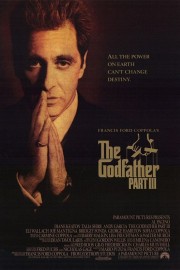The Godfather Part III
Years after watching, and reviewing, the first two “Godfather” films for Sonic Cinema, it is finally time to watch the black sheep of the trilogy, “The Godfather Part III.” I’ve only seen the film once, back after watching the first two films in the ’90s, and I liked it. I knew then that it wasn’t as good a film as Francis Ford Coppola’s Best Picture-winning first two films, but it wasn’t nearly as bad as some people had said. Nearly 20 years later, and 25 years after it’s release, it’s time to see how it holds up.
The story for this film comes from Coppola and author Mario Puzo, and was intended to put a poetic bow on the tale of Michael Corleone (Al Pacino), the former war hero who was tapped by his father, Vito Corleone, to take the family business into legitimacy. By the end of “Part II,” he had failed to do so, and ended a shell of the man he was when we first saw him in the first film. Everyone around him was gone, either through death or being pushed away by the man Michael had become. By paralleling the rise of Vito through organized crime in flashbacks with the downfall of Michael in the second film, the impression was that Puzo and Coppola had finished their story. Financial hardships on Coppola’s part, however (due to multiple failures at the box-office) lead to him returning for one last story in his and Puzo’s world. When Michael says during the film, “Just when I thought I was out… they pull me back in,” that is Coppola’s sentiments exactly, and it shows through the film.
The year is 1979. Michael is an old man. The years have not been kind to him physically. Or spiritually, in the years after ordering the death of his brother, Fredo. Financially, however, he has prospered, and spent his time doing charitable work through a foundation named after his parents, and run by his daughter (Mary, played by Sofia Coppola). He still speaks with, and loves, Kay (Diane Keaton), the estranged mother of his children, but she doesn’t see him as a changed man as others do. He is very close to his sister, Connie (Talia Shire), who is about the only person left from his early life by his side. When we first see him in “Part III,” Michael is being rewarded by the Catholic Church for his philanthropic efforts. There are undercurrents, however, that begin to show cracks in Michael’s legitimate life, starting with the arrival of Vincent Mancini (Sonny’s illegitimate son, played by Andy Garcia) to the celebration. Vincent went to work in the criminal life after turning down a chance at legitimacy with Michael, and now, he has a beef with enforcer Joey Zasa (Joe Mantegna). This is the catalyst for Michael’s return to the life he has spent a lifetime trying to not be a part of. As with every other moment he has had to protect his family, though, it’s filled with difficult choices, and doesn’t always work out.
Like it’s predecessors, “The Godfather Part III” moves at a brisk, gripping pace– this is a story, and world, Coppola loves in his bones, and he is not one to half-ass it. He immerses us in the life of the Corleone clan, and we can’t help but follow it to the end. The problem, however, is that the story Coppola is telling is not worth the effort. Compelling? Yes, but unnecessary. While the inspiration he found in headlines about Vatican corruption is an intriguing basis for a crime film, it didn’t really need to be worked into a punctuation on the Corleone saga. Since it stands as such a film, however, it must be judged on those grounds, and regardless of what you think of it compared to it’s predecessors, it’s still a fascinating film. Coppola and Puzo decided to, once again, examine power, family, and spiritual corruption in a way that is impossible to forget, as the sins of Michael’s past continue to haunt him, and make a legitimate life impossible. The final fate of Mary may be a blessing for those viewers who couldn’t stand Sofia Coppola’s tone-deaf performance, but it’s nonetheless an inspired conclusion to the saga, as Mary represented Michael’s greatest hope for a life of peace, one that is lost to him forever in one quick burst of violence, which reminded me of the one perpetrated by Michael which lead him into this life to begin with.
The final moments of “The Godfather Part III” are interesting. After the story ends proper, we see flashes of Michael from his past, as he dances with the women in his life that he loved most. We then see him as an old man, dressed much like his father did in his later years, sitting alone at an old Italian home. He keels over, and dies. It’s easy to see the immediate moments before this scene as a dying man’s final thoughts, but what if all of what came before, not just the events of “Part III,” but the first two films, are intended as the dying memories of an old man, who looks back on his life, and wishes he had made another choice? Maybe Coppola has insights on his commentaries for this film that I need to hear to know for sure, but it would definitely make the flawed conclusion he offered up for his trilogy worthwhile if this were true. For director and star, the glory days of their younger years (which offered Pacino an unforgettable role, played unforgettably) were long behind them. Even though their last collaboration in the Corleone world doesn’t quite match up, it certainly gave them the chance to put an indelible coda on the character they brought to life.










